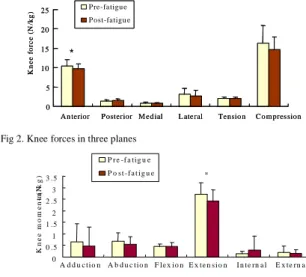中國醫藥大學教學卓越計畫 P3-4 研究學習群之推廣
校級研究成果發表會及國科會大專學生參與專題研究計畫撰寫研習營
The effects of lower extremity fatigue to knee joint loading during stop-jump
Hsiang Yi Hsu, Wei Hsien Hong*, Wen Chi Chen, Weng Cheng Chang Department of Sports Medicine, China Medical University, Taichung, Taiwan
*Email: whhong@mail.cmu.edu.tw INTRODUCTION
Knee joint has the highest using frequency in human body, and there are at least one hundred and forty-five millions people suffering from them every year [1]. Previous studies have suggested that sports injuries often occur in the late of competition, that is to say, fatigue may be a factor of sports injuries [2] in sports requiring sudden stops or landing from a jump [3,4]. However, the association between fatigue and knee joint loading remains anecdotal. Therefore, the purpose of this study was to determine the effects of lower extremity fatigue to knee joint loading during stop-jump task.
METHODS
Subjects- twenty healthy college students (10 males and
10 females), averaged age was 21.2 years, without known history of knee disorders were recruited as the subjects for this study.
Instrumentation- A Vicon 612 motion analysis system
(Oxford Metrics Ltd, Oxford, UK) included six infrared cameras and two AMTI force-plates were integrated to collect data simultaneously by using a 250 Hz sample rate. A set of 15 reflective markers will be placed on selected anatomic landmarks bilaterally on each subject in order to estimate the movements of segments [5].
Experimental Procedure- A 10-minute self-directed
warm-up was allowed for each subject. The task consisted of a 15-meter approach run followed by a 1-footed takeoff, a 2-footed landing with each foot on a separate force plate, and a 2-footed takeoff for maximum height. Each subject performed 5 trials for each stop-jump task in a pre-fatigue exercise test and immediately after completion of the fatigue protocol for the post-fatigue exercise test.
Fatigue Protocol- A fatigue exercise was used to create
the fatigue state for subjects. The subjects were asked to stand on two force plate by each foot, then, do their best to complete a vertical jump consecutively at least one minute. The knees have to squat to 90 degree in every vertical jump.
Data analysis- These data were analyzed by MATLAB
program. The definition for period of stop-jump is that starting from a single foot jumps away from the ground, throughout a sudden stop on force plate, then the end of jump away from the force plate. Knee joint force and moment were analysis by inverse dynamic method [5]. The paired t test was used to examine the effects of fatigue on knee forces and moments. A α level of p <0.05 was selected to determine statistical significance.
RESULTS AND DISCUSSION
The results showed that the tibial anterior shear force and compression force were large during stop-jump (Fig 1). The peak proximal tibial anterior shear force (p<0.05) (Fig 2) and knee extension moment between pre-fatigue and post-fatigue had a statistical significance (p<0.05) (Fig 3).
Fatigue may be the factor for losing motor control
from decreasing proximal tibial anterior shear force. The result was not consistent with previous study [2].It may be due to subjects realized their lower extremities strength was insufficient after the fatigue protocol, then they did not do their best to complete the task.
Fig. 1. The knee joint forces. Ant-Post: anterior(+)-posterior (-) force; Med-Lat: medial (+)-lateral (-) force; Ten-Comp: Tension (+)-compression (-) force.
Fig 2. Knee forces in three planes
Fig 3. Knee moments in three planes
CONCLUSIONS
There were lower anterior shear force and extension moment after the fatigue protocol, and was inferred to be related to neuromuscular physiology. Because there are many limitation of the experimental design, we will add electromyography (EMG) data to analyze the muscle control mechanism during stop-jump in future study. REFFERENCES
1.Tegner and Lysholm. Clin Orthop, 198, 43-49, 1985. 2.Chappell et al. Am J Sports Med, 33, 1022-9, 2005. 3.Boden et al. Orthopedics, 23, 573-8, 2000. 4.Yu et al. Am J Sports Med,32, 1136-43, 2004. 5.Haug, New Jersey. Prentice-Hall, 71-5 and 207-13,
1992.
ACKNOWLEDGEMENTS
This study is supported by grants from the China Medical University, Project no. CMU94-178.
-20 -15 -10 -5 0 5 10 0 10 20 30 40 50 60 70 80 90 100 Cycle of stop-jump (%) Kn ee f or ce ( N /k g) Ant-Post Med-Lat Ten-Comp Ant-Post Med-Lat Ten-Comp 0 5 10 15 20 25
An terior Posterior M ed ial L ateral Tensio n C o m pression
K n e e fo rc e (N /k g ) Pre-fatigu e Post-fatigu e * 0 5 10 15 20 25
An terior Posterior M ed ial L ateral Tensio n C o m pression
K n e e fo rc e (N /k g ) Pre-fatigu e Post-fatigu e * 0 0 .5 1 1 .5 2 2 .5 3 3 .5 A d d u c ti o n A b d u c t io n F le x io n E x te n si o n I n te rn a l E x te rn a l Kn e e m o m e n t (N -m /k g ) P r e -f a tig u e P o st -f a t ig u e *
